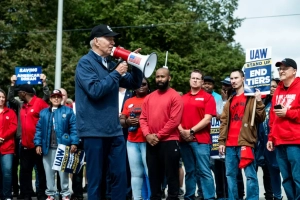AUTOWORKERS TAKE ON BIG THREE IN HISTORIC STRIKE

Union workers rally for a fair contract. Photo: In These Times
Once upon a time, autoworkers had the best jobs in American manufacturing industries. It was a time when unions were instrumental in building our country’s middle class. Workers at GM, Ford, and Chrysler were able to buy the new cars they were producing. They were able to afford a modest home, to send their children to a state university, to take a family vacation once a year. Flint, Michigan, home of the Fisher Body plant that built the bodies of GM cars, was a prosperous town.
But not any more. For the past four decades, as unions have come under attack from corporations and governments, led by right-wing Republicans (with help from some corporate-friendly Democrats), their strength has waned as their membership severely declined. Along with it, the middle class has been slowly disappearing along with areas of poverty in what had been the manufacturing belt of the country. And autoworkers along with the others have taken it on the chin. Many of their gains, hard won through years of struggle and union organization, were lost. Their union, the United Auto Workers, wound up negotiating union contracts that gave back gains in salaries and pensions, and that created a two-tier wage and pension system in which younger workers could never achieve the benefits their elders had won.
The defining moment came with the union contracts over the past decade when workers made big concessions after the companies pleaded that, facing foreign competition, they were in danger of closing down their factories. The workers made sacrifices while the companies piled up record profits. In just the first six months of this year, the Big Three – GM, Ford, and Stellantis (formerly Chrysler) – have reported $21 billion in profit and $5 in stock buybacks, rewarding their big shareholders with billions and their CEOs with annual compensation like GM’s top banana’s $29 million last year. And all the while, pleading that they couldn’t afford to give workers the pay and benefits they needed to catch up with some of the things they had lost. Meanwhile, the real wages of workers who make the cars have dipped by 30 percent over the past 20 years. Some make only $15.75 an hour, often having to work long overtime hours just to be able to support their families.
But now, finally, not any more say autoworkers and the UAW. Earlier this year, with some of the old leadership in jail for corruption, the membership elected new leaders by direct ballot, the first time in the union’s history.
With new leadership at the helm, led by its president, Sean Fain, the biggest labor news this September has been the strike at selected sites of the Big Three, involving thus far about 15,000 workers, with the promise that this is just the opening salvo if union demands are not met. The strike has evoked strong support from a number of Democratic officials and lawmakers and as this article was being written, President Biden was making a special appearance on their picket line.

“Unions built the middle class,” President Biden shouted through a bullhorn on Tuesday. “It’s a fact!”Credit…Pete Marovich for The New York Times
What’s at stake? Aside from signaling that workers have had it and were not going to take it anymore, the specific demands of the union include:
- Ending tiers.Before a major contract concession in 2007, newly hired auto workers could reach the maximum wage rate within three years and have guaranteed pensions and retiree healthcare. But “second-tier” workers — those hired since 2007 — must wait at least eight years before reaching top wage levels and get no pensions or post-retirement healthcare. The Big Three have also increasingly hired workers as low-paid temps, often extending the length of their supposedly “temporary” status before they can become permanent employees. The UAW wants to equalize pay and benefits so that all autoworkers, now and in the future, have pensions and retiree healthcare, and can reach maximum pay and permanent status within 90 days of being hired.
- Double-digit raises.The multimillionaire CEOs of GM, Ford and Stellantis have gotten an average raise of 40% over the past four years, so the union is seeking similarly large raises of around 46% for autoworkers over the course of the four-year contract. The UAW is also calling for significant increases to the pension benefits paid to retirees.
- Restoring cost-of-living adjustments (COLAs), which tie wages to inflation.Once a signature feature of autoworker contracts, the UAW’s former leadership agreed to suspend COLAs in 2009 as GM and Chrysler faced bankruptcy amid the Great Recession.
- Work-life balance.Because their real hourly wages have fallen so dramatically amid years of concessions, many autoworkers put in 60 to 80-hour weeks to make ends meet, leaving less time to spend with their families. In addition to calling for more paid time off, the UAW is making the eye-catching demand for a 32-hour workweek at 40 hours’ pay. “If Covid did anything, it made people reflect on what’s important in life, and it sure as hell isn’t living in a factory,” Fain said last month.
- Job security.With automakers shutting down factories and moving production to wherever in the world they can exploit workers the most — a process that has gone on for over 40 years and continues—the UAW is demanding the right to strike over plant closures and is calling for the creation of a Working Family Protection Program, which would make the companies keep employees at shuttered factories on payroll doing community service work.
- Enhanced profit sharing. With the Big Three’s shareholders reaping the benefits of record profits, the union is proposing that workers get $2for every $1 million spent on stock buybacks and special dividends.
- Ajust transition to electric vehicle (EV) manufacturing. Aided by federal subsidies, the Big Three are building EV battery plants as “joint ventures” with South Korean tech firms. But these new factories fall outside the collective bargaining agreements covering other UAW autoworkers, so wages and working conditions are far worse than at plants making gas-powered cars. As part of its fight to eliminate all tiers, the UAW wants to extend the same union standards to new EV plants. Since EV workers are not currently covered by the Big Three contracts, this is a public demand rather than a bargaining proposal.
A recent Gallup poll found that an unprecedented 75 percent of Americans side with the union in their contract fight. And it is, so far the biggest news in the current drive of American workers for a fair share of the wealth they are producing.
“Working people in this country know what’s really going on,” Fain said in a recent video. “We know what it’s like to live paycheck to paycheck while the companies we work for make out like bandits…We know the truth, and the truth is that the cost of a strike might be high, but the cost of doing nothing is much higher.”
For the UAW rank-and-file worker, a retiree and former president of UAW Local 909 in Warren, Michigan, put it simply. “I think for the UAW rank and file it is so refreshing to see this and to begin to identify with the UAW that they want to identify with.”
NY Times, 9/26; In These Times, 9/11; The Lever, 9/12; The Atlantic, 9/15; Canary Media, 9/19; Portside, 9/18; courtesy Locker Associates, NY, 9/20.


